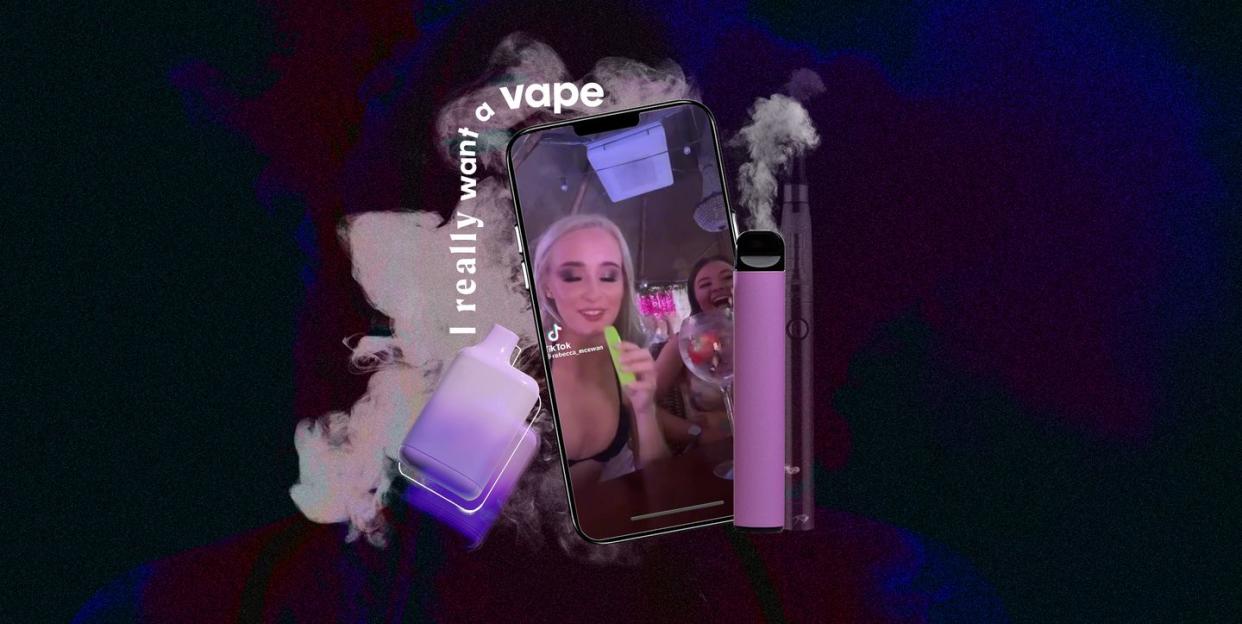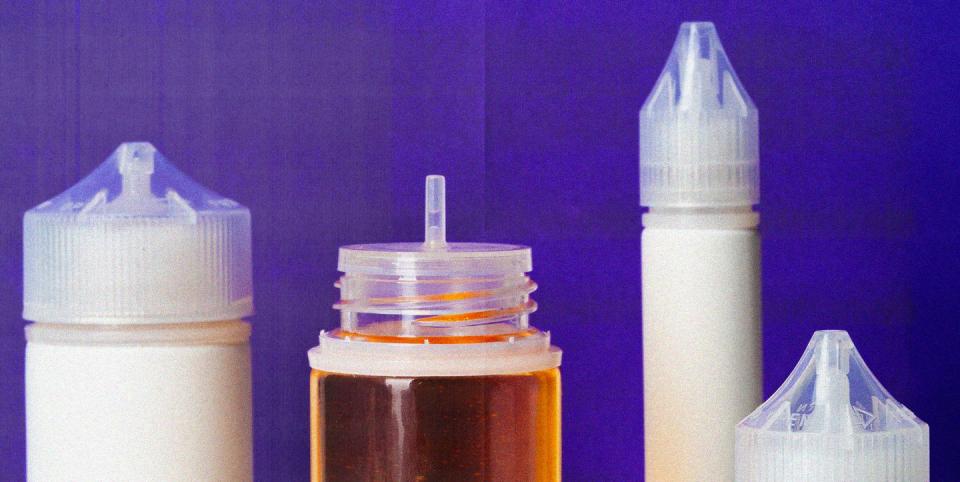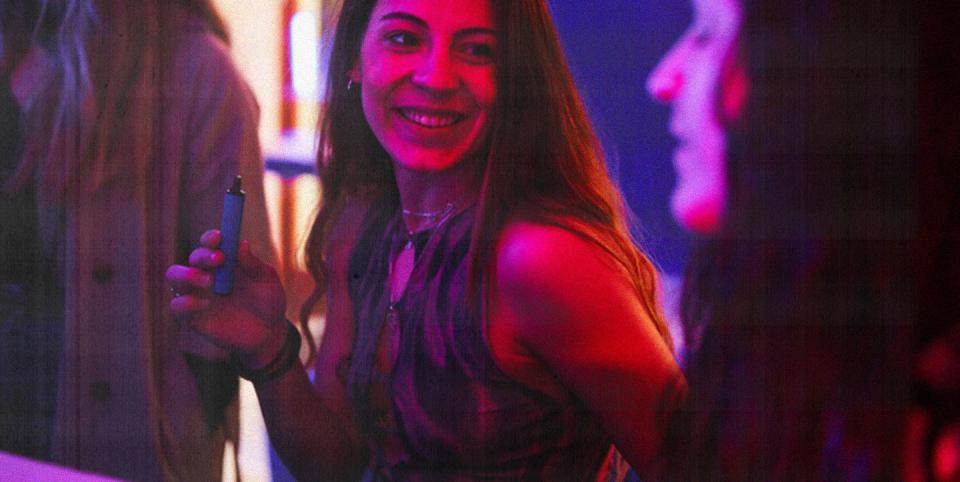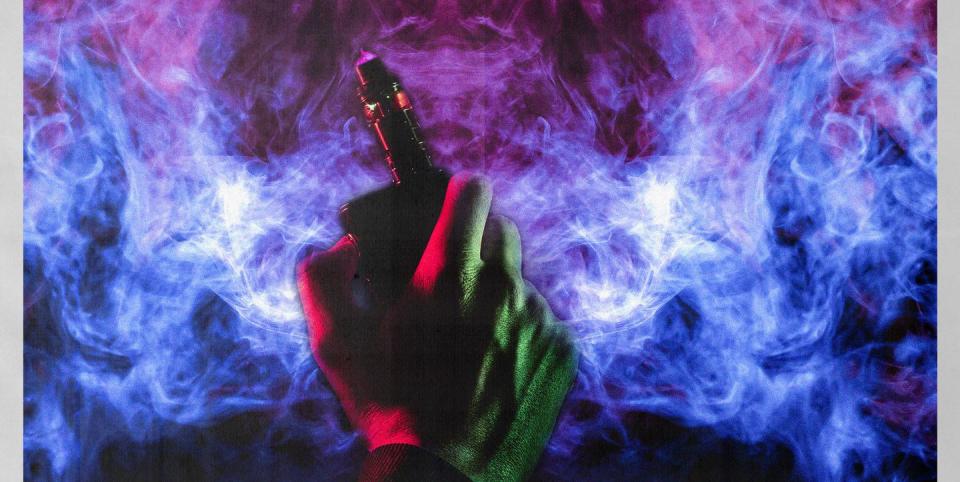What's actually in a vape? The answer is murkier than you'd think

The thing is... I really want a vape.
I’ve just spent the past 30 minutes discussing the dangers of the candy- adjacent, nightmare-dressed-as-a-daydream habit that has, of late, engulfed every festival, street and even school bathroom in a sweet, enticing fog. ‘So,’ I said, role-playing as a sensible journalist, all smart in my oversize suit jacket. ‘It’s essentially playing a lottery with your lungs?’ The woman opposite me, Jeanelle de Gruchy, England’s deputy chief medical officer (so incredibly smart and grown-up) nodded. I nodded back; smiled. See, I thought, I’m giving off the impression of someone who would never do anything as silly as vape.
But here I am, mere minutes later, outside her offices at the Department of Health and Social Care in the tepid summer heat, rummaging in my bag for the little pink tube that I’m sure is in here. Where is it?
It feels like vapes just appeared in a puff of sweet smoke and now – like it or not – they’re everywhere. If you’re not vaping yourself, chances are you know someone who is, not to mention the endless stream of celebrities and influencers whose vaping habits hit headlines and get made into memes – from expert smoke rings (Kylie Jenner) to asking fans to locate their lost vape on stage (Lana Del Rey), while TV shows such as Euphoria see the cast rarely without a vape pursed between their lips.
But while their growth has been exceptional over the past few years, the first e-cigarette was actually invented in the 1960s, sold as an alternative to smoking as it was an effective way to get a nicotine hit without inhaling cigarettes’ known carcinogens, such as tar, carbon monoxide and other toxic chemicals.
However, reusable e-cigarettes did pose one problem: they were an expensive investment upfront, and a bit of a faff to charge and refill with sticky vape liquid. So, in 2019, along came the first disposable vape – cheap, easy to use and in an array of fruity flavours. Win-win for those giving up smoking, right? But it’s not quite that simple. Their availability has pulled in a whole new market; people like me who have never smoked, but now vape instead. And, as I’m about to find out, thousands of us could still be inhaling illegal levels of toxic chemicals and dizzyingly high volumes of nicotine without even knowing it.

Berry, Watermelon or Arsenic?
Do you have anything bigger?’ I’m role-playing again, standing in a mobile phone shop, marvelling (in a way I fear is a bit OTT) at the array of disposable vapes lined up behind glass. Aside from feeling as if I’m auditioning for an adult movie with this kind of dialogue, I’m trying to get the incredibly polite, slightly suspicious shopkeeper to sell me an under-the-counter vape. Waiting around the corner are Doug and Bill from Trading Standards Hammersmith, who have – for the past year or so – found that counterfeit vapes have accounted for a ‘significant part’ of their working days.
As we walk up and down the high street, where the pair have recently completed 53 seizures, they show me one of their recent counterfeit finds – which looks, well, like most other vapes... except it’s in an evidence bag. The packaging has a QR code saying it contains 2% nicotine, but Doug and Bill tell me the strength is actually the equivalent of 500 cigarettes. In one vape.
The pair are at the forefront of the latest (very legitimate) fear surrounding vapes. Because, while more of us are vaping than ever before (an estimated 4.3 million people in Great Britain, up from 800,000 a decade ago, with 53% of students said to be vaping, 27% of whom say they’re addicted), exactly what we’re inhaling is largely unknown.
Unregulated and illegal vapes are infiltrating schools (where there’s been a rise in tuck-shop-style dealers selling them to fellow students) and shops, via local distributors. Shops like the ones we go into in Hammersmith: newsagents, vape shops and, a real target for Doug and Bill, mobile phone shops that haven’t sold licensed products before, so may not be as vigilant when it comes to what they’re selling and who they’re selling to.
Despite being an over-18 product, vape use among children is a huge concern, with one in five 15-year-old girls in England said to be at it, while in Scotland, there’s been a threefold increase in 13-year-olds trying vaping. Anecdotally, I know teachers whose pupils are ‘continually’ trying to sneak puffs under their desks, friends who will Deliveroo themselves vapes at 3am and ex-smokers who’ve found themselves puffing on their vapes way more than they ever smoked. One friend even told me that he – almost unconsciously – wakes in the middle of the night to grab his vape of his bedside table. Then there's the rise in 'Vapewear designs', hoodies, watches and hats that disguise vapes making discrete vaping in public even easier.
Disposable vapes are easy and cheap to get a hold of (the average cost of a disposable vape is £5) but, as I soon learn, the rapid rise in their popularity has resulted in an almost wild-west of product that's incredibly hard to monitor and control. As the huge amount of nicotine per bar isn’t the only concern.
Tom Coleman is vape team lead at Inter Scientific, a laboratory in Liverpool that works with vape manufacturers to ensure regulatory standards are met. The lab recently paired with the BBC and analysed 18 vapes gathered at Baxter College in Kidderminster and found some of them to contain more than twice the safe amount of lead and nine times the safe amount of nickel. Arsenic and formaldehyde have been found in a separate test carried out by Trading Standards. ‘The metals found shouldn’t be anywhere near these products,’ explains Coleman. ‘It’s hard to say without analysing how the vapes were made, but it’s probably because of the coil inside degrading as it burns. It’s an indicator of a really cheap, poorly made product.’
‘There are so many illegal products out there,’ says Kate Pike, the Chartered Trading
Standards Institute lead officer for vaping, who’s also part of the government’s new
£3m ‘illicit vapes enforcement squad’, tasked with cracking down on illegal vapes entering the country. ‘The shops don’t even bother hiding them, and it feels as if as quickly as we’re taking them off the shelves, they’re being replaced,’ she says.

The devices themselves, Pike explains, have been shipped in from China and the majority are disposable. ‘We’ve had far fewer problems with [reusable vapes], it’s all the ones that look like highlighter pens, in bright colours and flavours, that are being shipped in.’ She tells me that many seem to be designed to appeal to teenagers, using (unlicensed and fake) branding including Prime Energy. ‘There’s also good evidence that organised crime is involved in the distribution networks, as essentially this product makes a lot of money and it’s far less risky than drugs – if you’re caught distributing illegal vapes, it’s a slap on the wrist, maybe a small fine.’
Recently, justice campaigner Richard Taylor said that vaping had taken over schools "like a plague" and said that county lines drug dealers are using illegal vapes as a way to recruit new teenager dealers, and that they then progress from dealing vapes to other Class-A drugs. Vape spiking is also on the rise, 26-year-old Chloe Hammerton collapsed at the Isle of Wight festival after taking a puff of a vape from a passerby in the crowd, with experts saying it's 'happening everyday.'
It's easy to think to read all of this, "OK, I'll just avoid illegal vapes then and I'll be fine" but, as well as it being almost impossible to tell the difference between a real and a fake vape, to confuse us even further, it’s not just the vapes illegally shipped in that are potentially harmful. Recently, e-cigarettes by a variety of popular brands were removed from supermarket shelves after being found to contain more than the legal limit of nicotine.
It’s perhaps not surprising, then, that The Royal College of Paediatrics and Child Health now says the UK government should ‘without a doubt’ ban disposable e-cigarettes. And, even as a guilty vaper myself, I have to admit it’s not hard to see why. But it’s a nuanced debate.
Blessing... or a curse?
‘Vaping has undoubtedly played a significant part in the drop in smoking in recent years,’ says John Dunne, co-founder of the UK Vaping Industry Association. ‘This year, we’ve reported 13.3% of adults aged 18 and over in the UK were smokers in 2021; this is a decrease from 14% in 2020. This is the lowest proportion of current smokers since 2011. In fact, using an e-cigarette as part of an attempt to quit smoking has some of the highest success rates, of between 60% and 74%.'
It’s why, when the government recently called on doctors and researchers to look into how to reduce the number of children accessing and using vapes, it reiterated the necessity of ensuring they remain available as a quit aid. ‘There’s a push to ban the flavours, but the difficulty is that scientific evidence suggests that the flavours help people quit, so you don’t want to close that door. But how do you balance that with protecting children? It’s not an easy policy discussion,’ explains Pike.
The emerging reality is that this isn’t exclusively the habit of ex-smokers substituting an existing nicotine addiction. It’s new smokers, as young as 13, giving themselves one. ‘The primary focus for [e-cigarettes] is to give up smoking,’ explains Dr de Gruchy. ‘But if you’re not using them for that, don’t vape. We don’t know the long-term impact on the lungs. Particularly for those under 25, as your lungs are still developing.’
Over on TikTok, discussions of ‘popcorn lung’ are rife. Videos range in extremity, from TikTokers breathing in and out, recording the crackling noise their lungs now make since taking up vaping, to others clad in hospital gowns, on oxygen. The condition gained its nickname when a group of popcorn factory workers developed it after inhaling diacetyl, a flavouring in popcorn. However, according to Cancer Research UK, it can also happen after an infection if it damages the lungs, or after breathing in chemicals that irritate the lungs and cause damage.
So, what’s the risk? Well, some of the liquid in e-cigarettes used to contain diacetyl, but this was banned in the UK in 2016 and – at the time of writing – there have been no confirmed cases of popcorn lung directly linked to vapes. Mostly, those posting popcorn lung videos are US-based (where the regulations aren’t as tight). But not all.

Abby Flynn, 20, from Milton Keynes, vaped one disposable per day (after never smoking a cigarette before) for a year and half and has now been diagnosed with the rare lung disease (officially known as bronchiolitis obliterans). While Inter Scientific said it hadn’t found any diacetyl in the vapes it tested, the impact of the other dangerous metals found in illicit vapes is obviously a huge concern, as they can damage the central nervous system and brain development (particularly in children). In the US, there’s been an ‘epidemic’ of evali (e-cigarette or vaping use- associated lung injury), a serious medical condition in which lungs become damaged due to substances contained in e-cigarettes.
However, close monitoring here has yet to show a similar danger – with (as of January 2020, according to publicly available records) only two fatal cases of evali being reported in the UK to date.
But when something becomes so popular so quickly, it can be incredibly hard to monitor, and other stories are emerging. Rosey Christoffersen, from Wirral, died in 2015 after her lungs collapsed when she was 18. While there was no inquest into her daughter’s death, her mother is convinced that vaping played its part. Then there’s university student Grace Brassell, who took to TikTok after she woke up ‘coughing blood’ and discovered in hospital that her left lung had collapsed. ‘This didn’t happen directly [because] of vaping,’ she said. ‘But the vaping could have killed me.’
So why, with all of this uncertainty, are we still hooked? Yes, nicotine is a highly addictive substance, but is there something else at play?
The dopamine cycle
Piled up in shop windows, they’re available in candy pink, sunshine yellow, cobalt blue; there’s an octagonal vape that shimmers, a sleek pen that’s both chic and discreet... I thought I was above all this; that I couldn’t be lured in by the sheer, dizzying array of choice. The fun, sweet flavours. But none of us are immune.
I spoke to addiction experts, behavioural scientists and marketing executives for this feature, and they all confirmed the (sadly very obvious) fact that as humans we like bright, shiny things in fun, sweet flavours. ‘Behavioural insights indicate that emotional triggers can play a vital role in forming habits,’ explains Aaron Wells, strategy director at Big Cat, an advertising agency specialising in using behavioural science to create positive health behaviour change. ‘Vaping companies capitalise on this by creating sensory cues and associations that elicit positive emotions. The use of appealing flavours, aesthetic designs and engaging sensory feedback upon inhalation taps into pleasure centres in the brain, establishing a connection between vaping and emotional gratification.’
We could also be lured into a false sense of security, that what we’re doing isn’t that bad for us, skipping the messaging that vaping is a healthier alternative to smoking and instead deciding it’s healthy in and of itself. ‘Or if not healthy, then at least something that’s both socially acceptable and free of any obvious downsides,’ explains Alan Gray, senior research psychologist at Tailify, an influencer marketing agency. ‘Brands also use colours and flavours associated with the wellbeing industry (cucumber and camomile).’
There are, he says, more than 1,500 different flavours of vape on the market today. Dan Judd, digital manager at Vape Superstore, says his outlet faces constant pressure to release more flavours, but he’s cautious to give in to demand before completing safety checks. As for the superstore’s most popular flavours? Blue raspberry, blueberry, watermelon and cherry. So while they don’t exactly scream ‘health queen’, they’re certainly preferable to the ashtray aroma that cigarettes give off. Charities have also raised fears that vaping could be linked to a rise in eating disorders, as they noticed a rise in people – particularly young women – opting to smoke a flavoured vape instead of eating.
Is it this – the feeling that a vape is ‘not as bad as’ a cigarette – that infiltrates our conscience the most? Because (and perhaps I’m kidding myself here) I’m not sure I buy entirely into Gray’s theory that we think of vaping as healthy. Most vapers I spoke to expressed that they knew, logically, the dangers, yet carried on regardless. ‘A friend of mine told me his kid brother stole a bunch of fake vapes and felt so guilty he buried them in the woods... I was like, please, tell me where they’re buried,’ joked one vaper I spoke to, before saying, ‘I know they’re dog shit for me, but I just like them.’ Another told me she’s been known to fall asleep with her vape in her hand, shrugging that it’s ‘just a naughty habit, really’.
It’s the ‘not as bad as’ alternative to smoking, but it’s also an accompaniment for that other emerging behavioural addiction of recent years: social media. My friends and I often discuss how vastly our behaviour has changed over recent years - how we used to be able to sit on a bus and watch, contentedly, people passing by the window. Now? The thought of ten-minutes without our phone to distract us feels hellish. I often find myself picking up my phone simply for something to do with my hands. A vape offers similar, I can fiddle and smoke and keep the mini hits of distraction coming...
‘Smartphones have messed with our dopamine regulation,’ explains Anna Lembke, a professor of psychiatry at Stanford University School of Medicine. (FYI, she’s also chief of the Stanford Addiction Medicine Dual Diagnosis Clinic and author of Dopamine Nation: Finding Balance in the Age of Indulgence.) ‘I see more and more people vaping and scrolling on their phones, thereby combining two things that flood their brains with dopamine. We also have more people than ever facing vaping addiction in our clinics, many being young people who had never smoked before.’
Speaking of that dopamine hit... the role that influencers, specifically those on TikTok, play in pulling in new vapers can’t be underestimated. Especially when around one in five never-smokers say they vape to copy others. There are lots of influential users who post reviews of their favourite flavours and even those who film ‘trains’ of all the disposable vapes they’ve bought over the years – lined up like dominoes across rooms. TikTok’s community guidelines prohibit any content that depicts or promotes the sale or trade of tobacco products, including vaping, and the platform tells me 77% of videos that violate this policy are removed within 24 hours of being posted. But some still slip through the net.
‘When a well-liked influencer pairs with a product, a little bit of their status and likeability is transferred to it. If you get it right, the product becomes rife with positive associations and transforms into so much more than just a disposable vape, or whatever it may be,’ adds Gray. ‘Products that are associated with a high-status influencer endorsement can quickly become “positional goods” – signalling status and belonging.’

One man who I wouldn’t have necessarily thought had the trendsetting power to influence people’s vaping habits is Phillip Schofield. Particularly when, at the time of writing, he has just appeared on the BBC to apologise for lying about his ‘affair’ with a younger colleague. Smoke poured from his mouth as he did so, the Double Apple Lost Mary twiddled constantly between his fingers. Yet Vape Superstore told me that sales of that flavour doubled within two days of the interview.
A recent study examined the impact television has on our tendency to smoke or vape (with the first season of Euphoria having the most e-cigarette depictions among shows released the same year) and discovered that constant exposure to vaping on TV triples a young person’s chances of vaping. This is nothing new; I remember watching Carrie smoke in Sex And The City and feeling a deep urge to, like her, accessorise all my outfits with a cigarette. Can nicotine’s grip on us ever be released, or will we just continue in this endless cycle?
The UK Vaping Industry Association has called for more stringent penalties to deter the illicit trade of e-cigarettes, including on-the-spot fines of at least £10k for sellers per instance. Meanwhile, brands such as Elf and Geek Bar have recently introduced QR codes to their packs, which can be scanned to show legitimacy (albeit vapes are often kept behind the counter, so it’s only after we’ve bought the vape that we can check). But it feels like the tip of the iceberg. We’re now getting through 2.7m disposable vapes each week in the UK, resulting in four being thrown away every second. So maybe make that the tip of a rapidly melting iceberg – environmental activists are also calling for their ban, as landfills are scattered with the neon devices.
The truth is, doctors are unable to pinpoint exactly what vaping could be doing to us. After all, in the 1950s, cigarettes were regularly prescribed to asthma patients and handed out to soldiers for free. But it was only in the late 1960s that their links with lung cancer became widely known.
It seems for every promising stat around vapes as quit aids, there are two other stats revealing the ominous and uncertain impact vaping is having on us. There’s also no denying the economic benefit of a thriving vape industry – in fact, tobacco companies have been known to fund ‘stop-smoking’ adverts, driving quitters to the vapes they also manufacture. I fear, as the vape at the bottom of my bag calls to me, that we’ve already been lured in – old smokers and new vapers alike – and in years to come, they could cause more problems than they ever solved.
Follow Catriona on Instagram here
You Might Also Like

